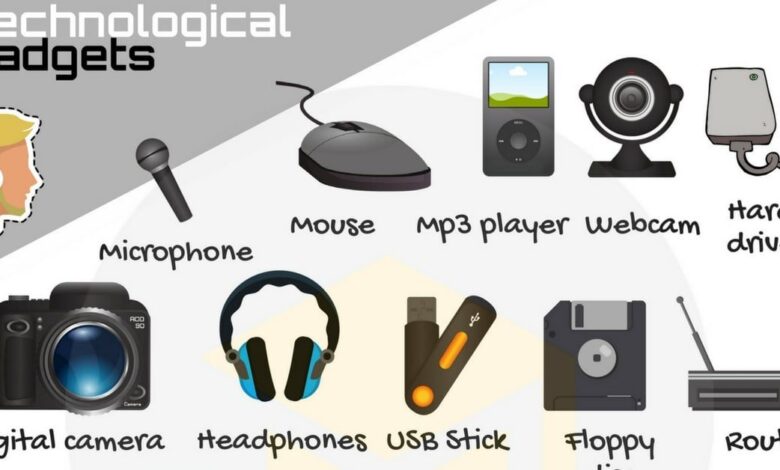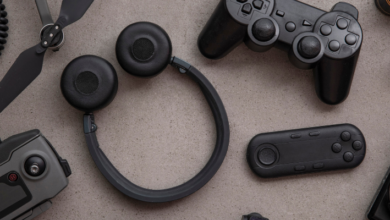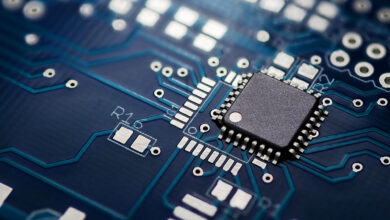
Technology gadgets are electronic devices that are innovative, useful, and provide entertainment or convenience. These devices integrate advanced technology and innovative design to enhance our daily activities. Tech gadgets have become must-have items for many consumers looking to simplify their lives and stay up to date with the latest innovations.
Some of the most popular types of tech gadgets today include smartphones, smartwatches, wireless earbuds, smart home devices, drones, virtual reality headsets, 3D printers, and smart appliances. Consumers are increasingly looking to tech gadgets to help them stay organized, productive, connected, and entertained. The past few years have seen some remarkable advances in artificial intelligence, voice control, wireless connectivity, sensors, high-resolution displays, and other technologies that have led to groundbreaking new gadgets.
The latest and greatest gadgets provide capabilities that would have seemed like science fiction just a few years ago. From phones that can be controlled by gestures to fridges that can automatically order groceries when supplies run low, today’s smart gadgets aim to make our lives more convenient. New gadgets are also focusing more on integrating technology into everyday items in an intuitive, aesthetic way. The boundaries between fashion, technology and functionality are blurring. In the coming years, we can expect gadgets to become even more intelligent, immersive, and interconnected. Exciting times lie ahead in the world of tech gadgets!
Smartphones
Smartphones have come a long way in the past decade, with rapid advances in technology leading to exciting new features and capabilities with each new model release. While the first smartphones like the original iPhone in 2007 focused on touchscreens and basic apps, today’s devices are packed with advanced computing power, high-res displays, AI-assisted cameras and a myriad of sensors.
The iPhone 13 Pro Max released in 2021 exemplifies the state of the art in smartphones today. Key features include:
- Display: 6.7″ OLED display with ProMotion 120Hz refresh rate for smooth scrolling and motion
- Chip: A15 Bionic, 6-core CPU and 5-core GPU delivers blazing fast performance
- Camera: 12MP main, 12MP ultra wide, 12MP telephoto with 3x optical zoom. New macro photography mode.
- Battery: All day battery life with fast charging that can reach 50% in 30 minutes
Samsung’s Galaxy S22 Ultra is a top Android alternative with its own impressive specs:
- Display: 6.8″ QHD+ Dynamic AMOLED 2X display with 120Hz refresh
- Chip: Snapdragon 8 Gen 1 chip, fastest processor on Android
- Camera: 108MP main, 12MP ultra wide, 10MP 3x telephoto, 10MP 10x telephoto
- S Pen stylus built in for drawing and precision work
Upcoming innovations we may see in the next generation of smartphones include foldable displays, under-display cameras, satellite connectivity, and advanced augmented reality capabilities. The future looks bright for these pocket-sized powerhouses!
Smartwatches
Smartwatches have rapidly gained popularity as a convenient way to stay connected, monitor your health, and access notifications right from your wrist. Modern smartwatches are packed with sensors and advanced features that go far beyond simply telling the time.
Key capabilities of smartwatches include:
-
Notifications – Get calls, texts, app alerts and more delivered right to your wrist so you don’t have to grab your phone. Many watches let you respond to messages too.
-
Health & Fitness Tracking – Built-in heart rate sensors and pedometers allow smartwatches to track steps, calories burned, heart rate patterns and more. Some can even take ECG readings. Sleep tracking is another common feature.
-
Apps and Customization – Install third party apps and customize your watch face for quick access to information. Streaming music offline with Bluetooth headphones is also possible on some models.
-
Payments – NFC chips allow you to store credit cards and pay right from your wrist. No need to carry your wallet for quick purchases.
-
Smart Controls – Control smart home devices, take photos remotely, find your lost phone and more, all from your watch.
Leading brands include Apple Watch, Samsung Galaxy Watch, Fitbit Versa and Garmin Vivoactive. Apple dominates the market, but Fitbit and Samsung lead with more affordable options.
Which smartwatch you choose depends on your smartphone platform, budget and fitness/health tracking needs. With advanced biosensors and increasing independence from phones, the device category continues to evolve rapidly.
Wireless Earbuds
Wireless earbuds have become increasingly popular in recent years, allowing users to listen to music and take calls without being tethered to their device. Key factors when considering wireless earbuds include audio quality, battery life, and wireless connectivity features.
The major players in the wireless earbud market include Apple, Samsung, Sony, Bose, and Jabra. Apple’s AirPods are among the most recognizable wireless earbuds, offering easy pairing with Apple devices. Samsung’s Galaxy Buds also have a loyal following and seamless integration with Samsung smartphones. Sony, Bose, and Jabra are respected for their audio engineering and noise cancellation capabilities.
In terms of audio quality, look for earbuds that offer clear mids and highs, powerful bass, and noise isolation. More premium models will support advanced audio codecs like AptX and AAC for enhanced sound over Bluetooth. Battery life is crucial as well, with most quality earbuds delivering 4-6 hours of listening per charge, with an additional full charge from the case.
For connectivity, Bluetooth 5.0 or higher is ideal for extended range and fewer dropouts. Some wireless earbuds also allow for simultaneous pairing to multiple devices which can be convenient for switching between a phone and computer. Additional features like sweat resistance, touch controls, hearing aid compatibility, and companion apps can also factor into your buying decision.
By weighing factors like brand reputation, sound quality, battery life, and connectivity, you can choose the right pair of wireless earbuds for your needs and budget. The top brands continue to deliver impressive innovation in this growing product category.
Smart Home Devices
Smart home devices are gadgets that are connected to the internet and can be controlled remotely, often via a smartphone app or voice assistant. Some of the most popular smart home devices include:
Smart Speakers
Smart speakers like the Amazon Echo and Google Home are voice-activated speakers that can play music, provide information, news, weather, control other smart devices, and more. Just speak out loud to activate the speaker’s voice assistant technology. Top smart speaker brands include Amazon, Google, Apple, Sonos, Bose.
Smart Lighting
Smart lightbulbs and lighting systems from Philips Hue, LIFX, Nanoleaf, and others can be controlled and automated through an app or voice assistant. Change light colors, dimness, create lighting schedules and scenes. Smart lighting provides convenience, energy savings, and ambiance control.
The Smart Thermostats
Smart thermostats like the Nest and Ecobee allow you to control your home’s temperature and HVAC system remotely via smartphone app. They use sensors to detect when you are home, optimize heating and cooling, and help save energy.
The Smart Security
Smart security systems like SimpliSafe and Ring Alarm feature connected cameras, doorbells, motion sensors, alarm keypads, etc. that integrate with your smartphone and allow remote home monitoring and alerts.
The Smart Appliances
Many modern appliances are getting smart capabilities. Samsung, LG, Whirlpool, and others make fridges, ovens, washers, dryers, dishwashers, and more that connect to WiFi for remote control, notifications, and voice activation.
In general, smart home devices connect via WiFi and offer convenience, customization, energy savings, and peace of mind through remote access and home automation. Leading brands provide their own apps to control the gadgets.
Drones Take Flight
Drones, also known as unmanned aerial vehicles (UAVs), have seen rapid adoption and advancement in recent years. From hobbyists to professionals, drones offer capabilities that were once only possible with manned aircraft.
Recreational vs. Commercial Use
Recreational users often enjoy drones for their ability to take unique aerial photos and videos. Many recreational drones have built-in cameras and automatic flight modes like “follow me” to simplify piloting and content capture. Popular recreational models include DJI’s line of consumer drones.
Commercial drone use has also grown exponentially. Drones enable inspections, mapping, surveying, search and rescue, delivery, and more. Commercial drones feature robust build quality, flight time, sensors, and range. Top commercial UAV manufacturers include DJI, senseFly, and Parrot.
Drone Features and Capabilities
Modern drones boast an impressive set of features:
-
HD Video Recording – Built-in 4K video cameras even on recreational drones.
-
Photography – 12+ megapixel still image capture, some with gimbal stabilization.
-
Autonomous Flight Modes – Pre-programmed cinematic shots, subject tracking, waypoint navigation.
-
Obstacle Avoidance – Onboard sensors detect and avoid objects in the flight path.
-
Extended Range – Some drones can fly 15+ miles from operator while maintaining signal.
-
Flight Time – Rechargeable batteries allow 15-30 minutes of flight, some drones have swappable batteries.
-
Speed and Agility – Racing drones can hit 50-70 mph while standard drones fly 10-35 mph.
-
Piloting Options – App or handheld remote control options for smooth, intuitive piloting.
Drone Photography and Videography
The biggest appeal of drones for many users is the ability to capture stunning aerial photos and video. Drones allow unique top-down perspectives and sweeping cinematic shots like reveals and flyovers.
Photographers use drones to showcase gorgeous landscapes and architecture. Videographers utilize drones for establishing shots, following dynamic action, and adding production value. Drones have become essential tools for filming movies, commercials, and other video projects.
With a mix of artistry and piloting skills, drone pilots can create breathtaking visual media. Post processing allows color correction and polish. Drone content provides immense creative possibilities compared to shooting from the ground.
Virtual Reality: Immersive Experiences in Your Own World
Virtual reality (VR) allows users to experience immersive, computer-generated environments and simulations. VR headsets like the Oculus Rift, HTC Vive, and PlayStation VR cover the users’ eyes and ears to transport them into an artificial world where they can interact with virtual objects and move around using handheld controllers.
A VR technology has opened up many exciting applications that go beyond gaming, which was its initial focus. VR allows for realistic training simulations that are being used in fields like medicine, aviation, and the military. Doctors can practice surgery in a risk-free setting, pilots can train for emergency situations without danger, and soldiers can prepare for combat scenarios to increase readiness. VR is also used for virtual tourism, allowing users to visit recreations of real-world places. Museums have created VR experiences to let visitors interact with historical artifacts. There are also VR applications in filmmaking, architecture, engineering, and science.
The future outlook for VR is bright, with untapped potential still to be explored. Advancements in VR equipment like wireless headsets, haptic feedback devices, and higher resolution displays will lead to more immersive experiences. The range of content and software for VR will expand beyond gaming into even more industries and applications. As the technology improves and becomes more affordable and accessible, VR may someday be as commonplace as smartphones. The next generation of VR aims to provide hyper-realistic simulations that are almost indistinguishable from real life.
3D Printers
A 3D printing technology allows users to create physical objects from digital models. 3D printers build up objects layer-by-layer using plastics, metals, ceramics, and other materials. Today’s affordable consumer models extrude melted plastic filament through a print head to shape each layer.
The 3D printing process starts with creating a digital model using CAD software or 3D scanning an existing object. The printer software then slices the model into thin layers that are printed one on top of the other until the object is completed. Each layer bonds to the previous layer as it cools and hardens.
3D printing enables rapid prototyping and cost-effective short-run manufacturing. It allows anyone to turn digital creations into physical objects at home. Common applications include:
-
Prototypes – Quickly create concept models, prototype iterations, and final products. Refine designs faster.
-
Customized objects – Create personalized products, toys, jewelry, art, decor, tools, and more. Customize existing objects.
-
Manufacturing – Produce end-use parts, manufacturing jigs, and other production tools. Build to order without mass production.
-
Education – Provide hands-on learning about design, engineering, technology, math, and more.
-
Medical – Create custom braces, prosthetics, anatomical models, surgical guides. Pursue emerging bioprinting.
Affordable consumer 3D printers now cost $200-$500. Popular beginner models include the Creality Ender 3 series, FlashForge Adventurer 3, and Anycubic Mega Zero. These fused deposition modeling (FDM) printers require some assembly and calibration but produce quality prints. Higher-end consumer printers boast larger build volumes, dual extruders, touchscreens, and WiFi connectivity for simplified printing. The possibilities are endless when you have the power to turn digital files into physical objects.
Smart Appliances
Smart appliances integrate internet connectivity and other technologies to add convenience and automation to everyday household tasks. Often referred to as “connected home” appliances, these wifi-enabled devices can be monitored and controlled remotely using a smartphone or voice assistant.
Some key benefits of smart appliances include:
-
Remote monitoring and control – You can check the status of appliances and adjust settings from anywhere using an app. For example, view what’s inside your refrigerator or change the temperature while away from home.
-
Scheduling and automation – Appliances can be programmed to turn on/off or run certain functions automatically at set times, like having your robot vacuum clean while you’re at work.
-
Notifications and alerts – Get notifications if a fridge door is left open, or when the dishwasher cycle is complete. Some appliances even diagnose technical issues and alert you to problems.
-
Energy efficiency – Smart features allow appliances to optimize energy use based on schedules and usage patterns.
-
Voice control – Many smart appliances are compatible with virtual assistants like Alexa and Google Assistant for hands-free voice control.
Some examples of popular smart appliances include:
-
Smart refrigerators – Have cameras inside to view contents remotely, sensors to track freshness, and the ability to maintain optimal temperature zones. Some have touchscreens for browsing recipes.
-
Smart ovens – Can preheat before you get home from work, monitor internal temperature with a food thermometer, and sync with your smartphone. Advanced modes include scan-to-cook using barcode scanning.
-
Robot vacuums – Self-navigating robots that clean floors independently, mapping your home and adapting to furniture. Controlled via a mobile app. Features include scheduling, room zoning, and self-emptying dustbins.
The smart appliance market continues to grow as more manufacturers integrate connectivity and automation features into large and small kitchen and home appliances. With benefits like remote access, voice control, and scheduling, smart appliances aim to simplify household chores and provide greater convenience in everyday living.
Conclusion
Summary of key gadget tech trends
Some of the most exciting tech gadgets trends we’ve seen over the past few years include the proliferation of smart home devices, the advancement of virtual and augmented reality, and the popularity of drones and 3D printers becoming accessible to everyday consumers.
Smart home devices like smart speakers, security cameras, video doorbells, and smart appliances allow users to connect, automate, and control their homes in new ways. Virtual and augmented reality headsets provide immersive gaming, training, and entertainment experiences. Drones and 3D printers tap into creativity and enable new photographic perspectives and rapid prototyping capabilities.
Underlying many of these gadget tech trends are advancements in artificial intelligence, computer vision, sensors, battery technology, and wireless connectivity. As these foundational technologies continue to evolve, consumer tech gadgets will gain new functionality and become even more integrated into our daily lives.
Final thoughts on the future of consumer tech gadgets
Looking ahead, we can expect consumer tech gadgets to become even more ambient, assistive, and personalized. Devices will adapt to users’ preferences and routines, proactively providing notifications, recommendations, and automations. Voice assistants are likely to become ubiquitous across devices. Wearables could increasingly augment reality and enhance skills.
While tech gadgets will aim to make daily life more frictionless, there are still risks around privacy, security, and over-reliance on technology. Responsible innovation and ethical technology design will be key. Overall, the future seems filled with possibility as gadgets gain new capabilities to simplify tasks, increase productivity, entertain us, and enrich our experiences.





